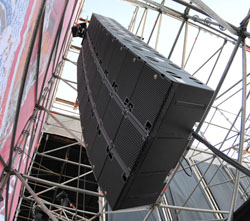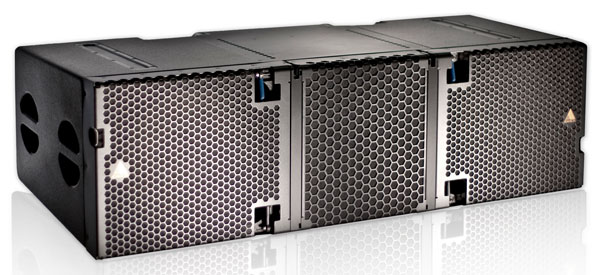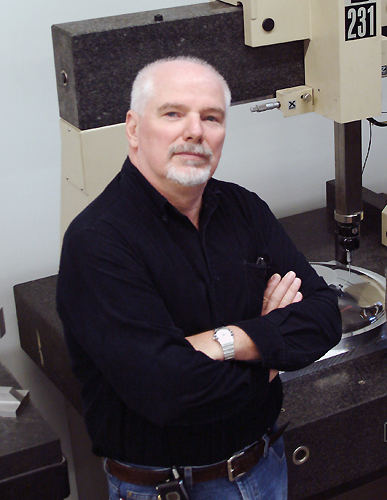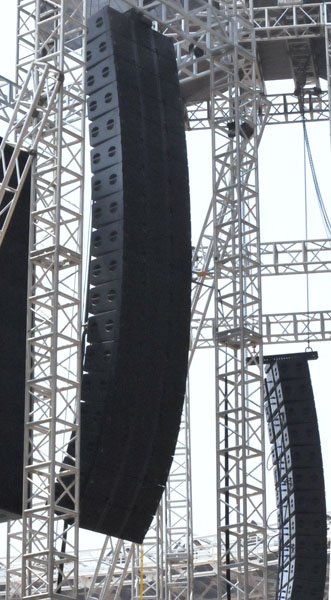
Last September, Adamson Systems Engineering made public some of the details of Project Energia, which includes a new series of loudspeaker systems with networkable Class D amplifier modules, DSP, cable and power distribution, AVB network hardware with software integration of control, and 3-D simulation and diagnostics. The system will be under touchscreen control.
Adamson is releasing information about Energia in phases, each defined by close work with several leading sound companies who agreed to serve as beta partners.
Phases include: 1) Mechanical field testing; 2) Amplifier, power distribution and ground control field testing; and 3) Network and network hardware field testing.
Beta phase 1 actually began in July of last year, with Eighth Day Sound (U.S.), Wigwam Acoustics (UK), Fluge (Spain) and Big Daddy Productions (Indonesia) taking delivery of E15 line source loudspeakers, which were subsequently used on a variety of fall tours and large-format events around the world. Several other significant beta partners, including Sound Image, have since come aboard.
The Energia package has, at this count, four related patents pending. The E15 is built around the e-capsule, a surrounding module constructed in aircraft grades of lightweight aluminum. This skeletal structure provides an accurate and rigid frame for mounting the modular Autolock rigging system, while simultaneously housing a series of mid/high components on proprietary Co-Linear Drive Modules.
The e-capsule is flanked with two separate birch ply enclosures, each containing a proprietary Kevlar 15-inch woofer, capitalizing on the advantages of Adamson’s Advanced Cone Architecture.
Autolock is designed for a single technician to be able to set all angles on the ground, with no lifting involved. When connecting the flown section of the array to the next flyable section on the ground, the cabinets lock together automatically. Four E15 cabinets will ride in a dolly.
Briefly, the E15 is a 3-way system, with 2 x ND15 15-inch neodymium Kevlar cone drivers (2 x 8 ohms), 2 x YX7 7-inch Kevlar cone drivers (2 x 8 ohms), and 2 x 4-inch (1.5-inch-exit) Adamson NH4 compression drivers. Frequency response is 60 Hz to 18 kHz, horizontal dispersion is 90 degrees (-6 dB symmetrical), and vertical dispersion is 6 degrees (prolate-spheroidal sound chamber).
The cabinet, made of Baltic birch with textured water borne acrylic finish, measures 15.4 (h) x 51.4 (w) x 21.4 (d) inches and weighs 176 pounds.
Beta phase 2 is underway, focusing on the Class D amplification, DSP and ground control system that will provide diagnostics, control of individual bands in each E15, and more. Beta phase 3 will address the network management system, including a totally new software suite.
We recently talked with company president and CEO Brock Adamson to get further details about the concept, how it’s gone so far, and where it’s leading.
PSW: What are your observations, in general, of the current line array/loudspeaker market in sound reinforcement?
Brock Adamson: It seems that new product expectations have been lowered to the level of incremental transducer improvement. But, since the first line array entered the market, there have been enormous advances in three technology toolkits that should have a much greater affect on the evolution of the array element: engineering software, electronics and system software integration. Not enough of this is finding its way to the modern line array.
How did this drive the concepts of Project Energia?
We were motivated to put together the very best mechanical design tools found in solid modeling, finite element and boundary element analysis to expand the existing constraints of form and function of the array element. Then we looked to electronics for cost effective, lightweight power and communications. We are also developing system integration with the next generation of network and software tools such as AVB and Android.
What attributes differentiate Energia from your previous line arrays?
Well, if we reduce all that to a set of attributes, it would start with “ergonomics” and end with “total solution,” “size” and “efficiency” somewhere on the list.
Why are you rolling out Energia in stages? When do you project that the initial product family, group, etc., will be completed and in full production?
Our strategy was established to ensure reliability at each phase of release. Energia represents a big step for our customers and for the company, particularly in the manufacturing stage. We are currently testing amplifier and power distribution hardware and the various aspects of AVB technology are just converging, with another IEEE document yet to be finalized.



